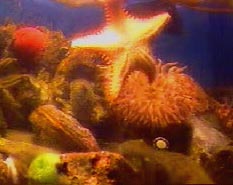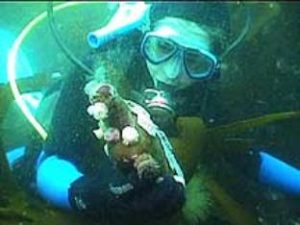-
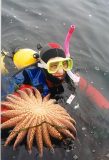
-
Loreen Pindera displays the oral side of the pycnopodia to shore-bound visitors.
-
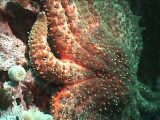
-
The dorsal side , with grey tufts where the gills are loated. White pincers on the dorsal side are the pedicellaria
-
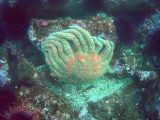
-
Photos by Pearson College Divers.
-
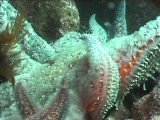
-
The tube feet of the Pycnopodia
-
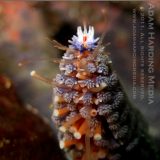
-
Adam Harding took this picture of the red eye spot at the end of a tentacle.
-
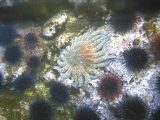
-
forcep-like structures used to defend the surface. A good habitat image of bith Pycnopodia and the giant red urchin.
-
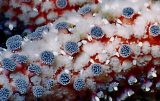
-
Close up of pedicellaria, tiny forcep-like structures used to defend the surface.
-
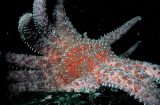
-
Pycnopodia : These three last photos are derived from photos by Dr.A.Svoboda
-
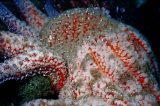
-
Dorsal surface showing gills
Pycnopodia tend to be found thriving in regions rich in seaweed, in low intertidal zones on rocky shores. They have an arm radius that ranges from forty to sixty-five centimeters. Small juveniles have five arms but develop twenty four by the time they are adults. Pycnopodia have an aboral surface and are usually pink, purple or brown in color. Occasionally they will be red or yellow in color. They also have the ability to regenerate lost arms. Pycnopodia are the largest, heaviest and most active of the Pacific coast sea stars. Pycnopodia feed on Stronglyocentrotus purpuratus (the purple sea urchin), bivalves, polychaetes, chitons, snails, hermit crabs, crabs, sea cucumber, and Leptasterias sea stars . The Pycnopodia utilize over fifteen thousand sucker feet when capturing prey. Their prey is swallowed whole and digested internally, and they have the ability to partially evert their stomach. Antagonistic, combative behavior has been observed when two Pycnopodia encounter one another. The key predator of the Pycnopodia is the King Crab. A fourfold increase in speed has been noted when the Pycnopodia is in contact with a predator. If the Pycnopodia does not escape, the predator will latch on to one of its many arms and begin to feed.
The sea star Pycnopodia helianthoides is one of the largest invertebrate predators at Race Rocks. In this close up view, on the dorsal side, the pinkish tufts contain the pedicellariae (small pincers) and the dermal branchiae (for gas exchange) On the ventral view, the central mouth is surrounded by many tube feet.
In October, 2001, federal Fisheries Minister Herb Dahliwal and the Provincial Environment Minister Joan Sawiki visited Race Rocks to officially proclaim the opening of the Race Rocks MPA. In this video, Ryan Murphy shows the ministers a Pycnopodia.
Domain Eukarya
Kingdom Animalia
Phylum Echinodermata
Class Asteroidea
Order Forcipulatida
Family Asteriidae
Genus Pycnopodia
Species helianthoides
common nameSunflower Star
References cited:
Marine Invertebrates of the Pacific Northwest, Eugene N Kozloff, 1996, University of Washington Press
Intertidal Invertebrates of California, Robert H Morris Donald P Abbot and Eugene C Haderlie, 1980, Stanford University Press
Pacific Seashores- A Guide to Intertidal Ecology, Thomas Carefoot, 1977, J.J. Douglas Ltd

